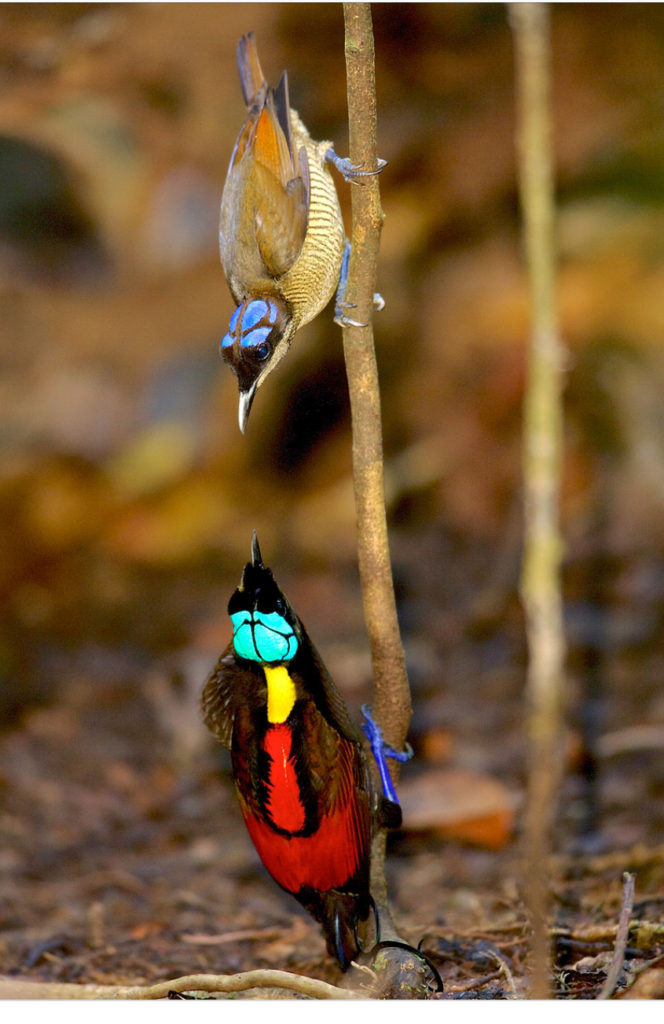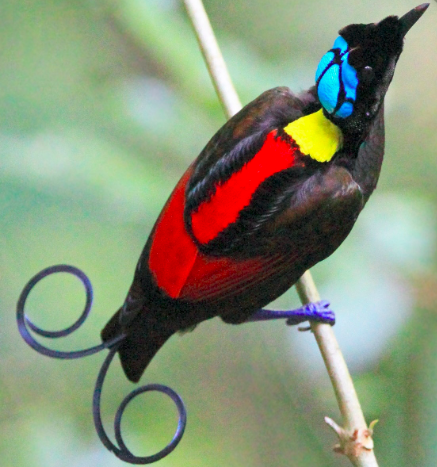Wilson’s bird of paradise.

Most of you have never seen a Wilson’s bird of paradise. Learn about their mating rituals and looks.
Before we start, shall we look at “The things you should know if you’re going to get a pet Wilson’s bird of paradise”? No. (Please don’t.) A male Wilson’s bird of paradise, at max, achieves a length of 6.3 inches and a weight of 1.8 – 2.2 ounces. Females can also reach a length of 6.3 inches, but have a slightly lesser weight. They eat fruits and a bunch of invertebrates (insects). They’re simply not available in the USA, so don’t try. To catch a glimpse, you need to go to the hill and lowland rainforests of Waigeo and Batanta Islands off of West Papua. There, search the places above 300 yards of altitude – Diphyllodes Respublicas like those places. Of course, you should ask the locals, first, if it’s legal to spy on the Wilson’s. Since you may not know the Batantan or the Waigeon language, use the scientific name: Diphyllodes Respublica. (I don’t know how to pronounce it either, but Mr. Watt tells me that the second syllable in Latin receives the stress.) Also it’s in the kingdom Animalia. The Phylum: Chordata. The Class: Aves. Order: Passeriformes. Family: Paradisaeidae, and Genus: Diphyllodes. Be extra careful, for as a result of habitat loss, it’s now evaluated as NEAR THREATENED on the International Union for Conservation of Nature (IUCN) red list of threatened species.
Now for the drumroll please… looks!!!

Males are red and black, with yellow mantles on their necks, bright green mouths, bold blue feet and two curved violet tail feathers. Their heads are blue with a black double cross. The females are different shades of brown with a bare blue crown. Male Wilson’s bird-of paradise have astounding color making them the most colorful of the type. This remarkable example of iridescence displays all of the primary colors in different ways. Yellow and red are plain yellow and red. However, green and blue look metallic because they’re made by light’s reflection off of the unseen structure of feathers and skin. The males also have yellow on the backs of their necks, followed by red inclining into purple, also, on its back. The baby blue on their heads is skin, not feathers, and no other bird of paradise has this. Its weird tail feathers are brilliantly iridescent too, reflecting light to make intense color for whoever’s looking. Females are different shades of brown. They also have the same blue head pattern as the male, just different shades of blue.
In the field, the blue skin on the male’s forehead is so bright that it’s clearly seen at night; the red back, the green breast, and curly tail glowing silver can be visible in very low light.
Last but not least: mating rituals. The sexual dimorphism of the species leaves the female, rather than eye catching, drab in comparison. It’s the result of female selection. That happens when females select mates based upon indirect genetic benefits (in other words, not marrying your cousin) which increase offspring’s ability to survive. Their survival is based on the females’ response to the dance, for she can study the male’s body very closely. Since this species is polygynous, which means that, in this case, one male has sex with many females, the female is on her own to hatch and raise young. This forces her to possess and control these indirect genetic benefits through mating traditions, to ensure her offsprings’ survival. While these birds are difficult to locate in the wild and have not been studied in-depth, footage of the few mating rituals which have been witnessed for this species tells all. The male defends a “court” from other males in which it performs its calls and physical dance moves. Males will restlessly work to keep this area free of debris, making sure that nothing on the ground will distract the female from their vivid colors. They will perch on a upright branch in the middle of their court, flexing the green collar to attract females to court. If she’s interested, she will perch above the male on a branch and watch as he paces back and forth, and squawks to her, while flexing the vivid collar. This great display of color demonstrates the power of female mate selection in the animal kingdom.
To conclude, the Wilson’s bird of paradise is a bird that’s rarely spoken of. I hope this essay inspires you to research and write about a special animal of your own.
